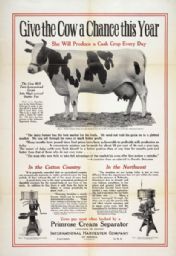Dairy Farming in Wisconsin
How Wisconsin Became the Dairy State
Dairying has been an important Wisconsin industry since the late 19th century. Wisconsin did not start out as a dairy state, however. The first generations of Wisconsin farmers considered wheat their main crop. Only after the Civil War, when soil exhaustion, insect infestation, and cheaper wheat from states further west threatened their livelihood did most Wisconsin farmers take up dairy farming.
Importance of Wheat to Settlers
Wheat was the earliest and most important cash crop for white settlers in Wisconsin. It required a small initial capital investment and was fairly easy to grow, allowing farmers to harvest two crops a year. The high rate of financial return made wheat an especially attractive crop for homesteaders in the mid-19th century.
Wheat provided a way for new immigrants in Wisconsin to farm cheaply and to deliver a product that many people needed. From 1840 to 1880, Wisconsin was considered "America's breadbasket" because one-sixth of the wheat grown in the nation came from Wisconsin. The early success of wheat farming helped Wisconsin's agriculture develop more rapidly than it did in other states.
Problems with Wheat Farming
Despite its appeal, wheat also had risks and disadvantages. It was hard on the soil, which it quickly depleted of nitrogen, an essential soil nutrient. Depending on the vagaries of the weather and insect populations, yield could vary substantially from year to year. By the late 1850s, the price of wheat began to drop as Wisconsin yields and quality diminished and competition increased from farmers in Iowa and Minnesota. Disaster struck in the 1860s, when tiny insects known as chinch bugs began devouring Wisconsin wheat crops.
To meet these challenges, farmers began experimenting with a variety of alternatives to wheat. Feed crops, rather than cash crops, were better suited to Wisconsin's soil and climate. These crops came to characterize the state's agriculture in the late 19th century.
Dairy Farming Takes Root
Starting in the mid-19th century, dairying emerged as the most viable alternative to wheat. The number of dairy cows increased rapidly in the second half of the century. By 1899, more than 90 percent of Wisconsin farms raised dairy cows.
Why the Dairy Industry Succeeded
The dairy industry expanded rapidly in Wisconsin for several reasons. Many of the enterprising dairy farmers who settled in southern Wisconsin in the 1840s and 1850s were New Yorkers. At the time, New York was the leading dairy producer in the nation. These New York settlers brought with them the skills needed for commercial dairying and butter and cheese production to Wisconsin. Most of the earliest dairy operations made cheese rather than butter because it kept longer in the days before refrigeration. Charles Rockwell was one of the earliest cheese makers in Wisconsin. He produced cheese at Koshkonong, near Fort Atkinson in Jefferson County, in 1837.
German and Scandinavian immigrant families were also quick to adopt dairying as a profitable way to farm. They specialized in European-style cheeses that appealed to consumers. Wisconsin became particularly well known for its Swiss cheese.
William Dempster Hoard
Much of the success of Wisconsin dairying can be attributed to the efforts of William Dempster Hoard, who tirelessly promoted the industry for nearly fifty years. He started the Wisconsin Dairyman's Association in Watertown in 1872. Though primarily a marketing association, the Dairyman's Association also provided education in new dairying methods through its publications and meetings. Hoard also established a dairy newspaper, Hoard's Dairyman, in 1885, which quickly became the nation's leading dairy magazine.
The University of Wisconsin
The spread of dairying was also helped by the University of Wisconsin, which actively promoted the industry in the late 19th century through scientific research. The first professor of agriculture, William A. Henry, used the University's farm to experiment with new dairying methods. The University also promoted the use of cylindrical silos for storing feed for cattle during the winter.
Professor Stephen Babcock developed the first test for butterfat content in milk. This allowed high quality butter and cheeses to be manufactured consistently. The University's College of Agriculture also pioneered testing for bacteria that led to practical methods of milk pasteurization.
In the 1880s, the University began offering agricultural "short courses" and "winter courses" in Madison to educate farmers on the benefits of dairying. Its Farmers' Institutes, held around the state, also brought farmers and scientists together to share ideas.
Professional Organizations
In the 1870s, leaders of the growing Wisconsin cheese industry organized several professional organizations to promote their product and to overcome farmer opposition to the cheese industry. The transition from wheat husbandman to herdsman had been difficult for many farmers. Providing milk regularly for cheese making required more regulation and a more confining routine for farmers used to working independently.
By 1915, Wisconsin had become the leading dairy state in the nation, producing more butter and cheese than any other state.
Learn More
See more images, essays, newspapers and records about Dairy Farming in Wisconsin.
Dictionary of Wisconsin History
Explore more than 1,600 people, places and events in Wisconsin history.
Sources: The History of Wisconsin, vols. 2 and 3 (Madison: State Historical Society of Wisconsin); Kasparek, Jon, Bobbie Malone and Erica Schock. Wisconsin History Highlights: Delving into the Past (Madison: Wisconsin Historical Society Press, 2004); "Economics in Wisconsin." The Wisconsin Mosaic (online at http://www.scils.rutgers.edu/~dalbello/FLVA/background/economics.html); "History" on Hoard's Dairyman (online at http://www.hoards.com/history/hilltop.html)]


